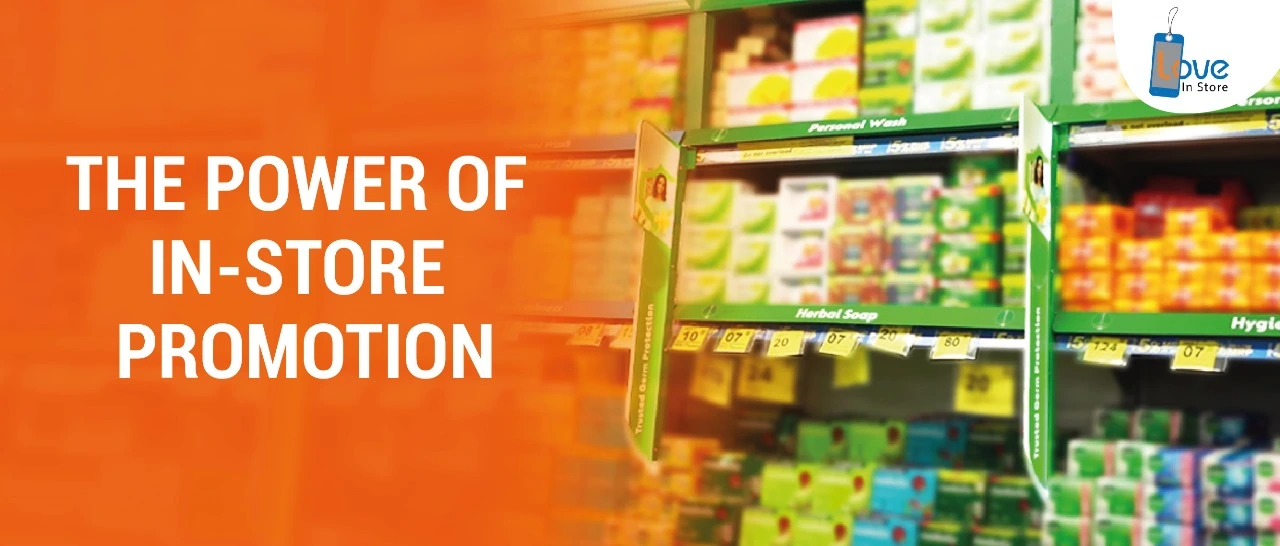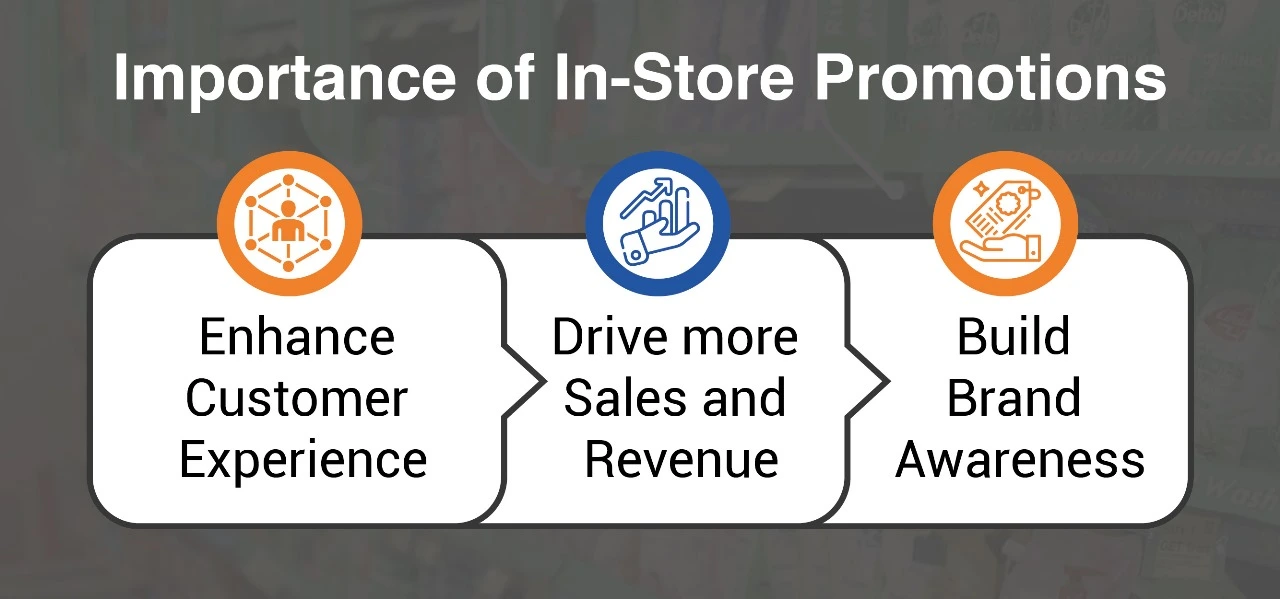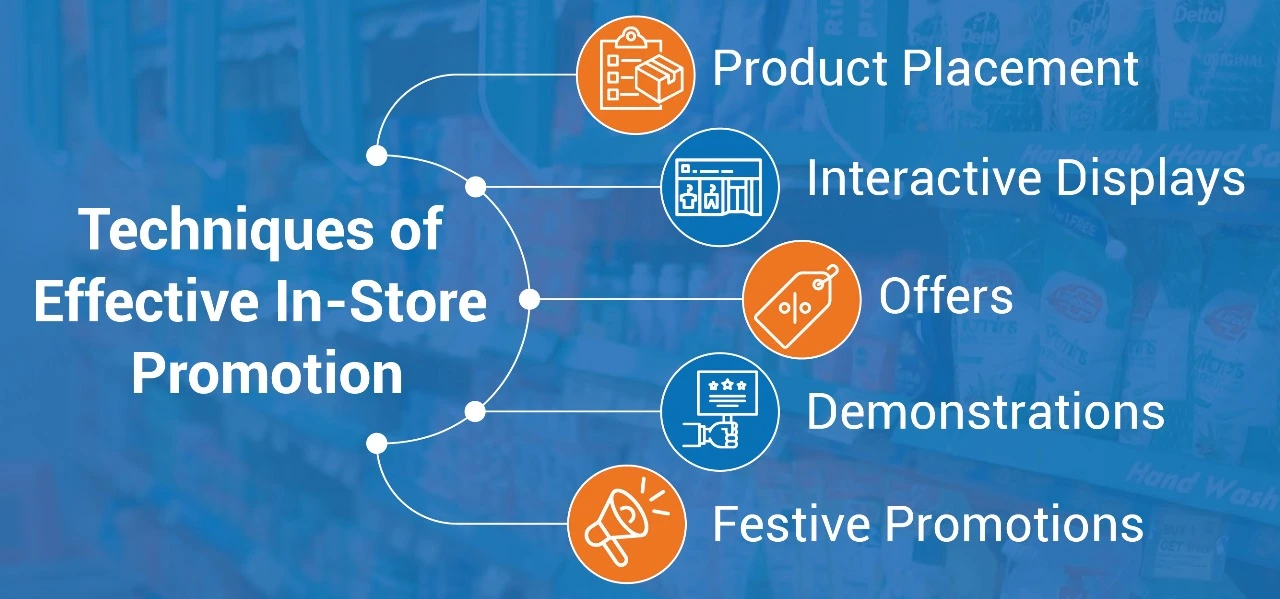
THE POWER OF IN-STORE PROMOTION
In the ever-evolving marketing era, in-store promotion is rapidly becoming an integral part of marketing. Brands constantly develop innovative strategies to capture customers' attention and boost sales. let’s explore the power of in-store promotion and how to create unique and immersive shopping experiences.
What is In-store Promotion?
In-store Promotion refers to a marketing strategy brands use to capture customers’ attention toward their products in physical and offline stores. By implementing special offers, discounts, sampling, and other promotional activities, brands enhance customer’s overall shopping experience and drive sales. These promotional activities attract customers and encourage them to buy their products while they are inside the store by creating a sense of urgency and excitement.
Importance of In-Store Promotions

Enhance Customer Experience
Besides simply displaying products on shelves, in-store promotions provide sensory experiences to the customers that create a dynamic and engaging atmosphere, unlike any other online shopping.
Drive more Sales and Revenue
In-store promotions when well-executed by the brand, have the potential to increase sales significantly. It encourages customers to try new products and make instant purchasing decisions.
Build Brand Awareness
Sample tasting, creative displays, and eye-catching offers help build brand identity and make a long-lasting impression on customers. In-store promotions help brands increase their customer base by appealing to customers to choose their products over competitors.
As much as in-store promotion is crucial for the brand to have a stronghold in the offline market, it is equally important to understand the techniques of in-promotion.
Techniques of Effective In-Store Promotion

Product Placement
Placement of the products plays a vital role in the effectiveness of in-store promotions for the brand. While considering the layout of the store, strategically placing the products at the entrance or near eye-catching sections of the store helps capture customers’ attention and boost impulse buying.
Interactive Displays
Incorporating attractive displays, posters, and screens at the store to provide additional information about the products and attract the attention of the customers. These displays help brands to attract customers to their products and make the purchase. Often these displays are strategically placed at the front of the store and also near cash counters in an attempt to leave a lasting impression on the customers. These placements are often decided by the brands as per their product categories.
Offers
Calling out limited-time offers on particular products helps create an urgency among the customers to make an immediate purchase. Not only limited-time offers but also regular discount offers also attract customers to make impulse buying.
Demonstrations
Product demonstration/sampling is one of the most effective techniques of in-store promotion that enables shoppers to experience products firsthand. This also enables brands to have a better understanding of customers’ requirements. Through sampling brands also try to influence the customers for brand switching.
Festive Promotions
Creating promotions aligned with festivals makes displays/offers more relevant and, also connects with the customers at an emotional level. This kind of promotion makes the brand their go-to choice for shopping for special occasions.
By planning and executing in-store promotions efficiently, brands can enhance customer experience, drive sales, and also build their loyal customer base. To execute these promotions, brands need well-trained promoters who can carry out the in-store activities efficiently to get maximum sales in return.
Promoters maintain healthy relationships with the store staff to ensure support by the staff when they need to carry out promotional activities in the store. They take up sampling and also keep an eye on the placement of the products. Promoters are like the brick of the in-store promotions.
For the companies/brands, it is very crucial to place well-trained promoters in the store. It is important to keep watch over the performance of the promoters and also give them training to maintain the quality of their performances.
LIS pitches in to fill in the gap between promoters and the brands. Love in Stores hires promoters for the brands as per their requirements and also trains/teaches them to get the maximum benefits for the brands. There are regular sessions to keep the promoters informed and up-to-date with new strategies and also to track their work performance. Working for some of the biggest brands in the country, professionals at LIS understand the markets and therefore, hire the best as promoters.
If you are looking to enhance your sales and boost your interactions with customers through in-store promotions, reach out to LIS @ info@loveinstore.com.
FAQs
Q: What is the role of an in-store promoter in retail?
An in-store promoter helps customers understand the features and benefits of products, enhances the shopping experience, and drives sales by offering product demonstrations or promotions within the store.
Q: How can businesses benefit from hiring in-store promoters?
Businesses benefit from in-store promoters by increasing brand visibility, boosting sales, and ensuring customers have a personalized shopping experience, which builds brand loyalty.
Q: What skills should an in-store promoter have?
In-store promoters should have excellent communication skills, product knowledge, a friendly demeanor, and the ability to engage with customers effectively.
Q: What are some effective store promotion strategies?
Effective store promotions include discounts, buy-one-get-one-free offers, loyalty programs, in-store events, and personalized product recommendations.
Q: How can store promotions increase foot traffic?
Store promotions attract customers by offering special deals and discounts, creating a sense of urgency, and providing unique in-store experiences that encourage visits.
Q: How do you measure the success of store promotions?
The success of store promotions can be measured by tracking sales growth, foot traffic, customer feedback, and the redemption rate of promotional offers.
Q: What is in-store marketing, and why is it important?
In-store marketing involves promotional activities conducted within the store to enhance the shopping experience, increase sales, and strengthen customer relationships.
Q: What are examples of in-store marketing tactics?
Examples include product displays, signage, interactive kiosks, samples, loyalty programs, and digital screens showcasing promotions.
Q: How can in-store marketing influence customer behavior?
In-store marketing can influence customer behavior by creating an immersive shopping environment, offering exclusive deals, and providing easy access to product information.
Q: Why is promotion important for retail businesses?
Promotion helps retail businesses increase product awareness, attract customers, improve sales, and stay competitive in the market.
Q: How does promotion impact customer decision-making?
Promotions impact customer decisions by offering value-added deals, fostering urgency to buy, and encouraging customers to try new products.
Q: What are the long-term benefits of consistent promotional activities?
Long-term benefits include increased brand loyalty, a steady stream of customers, and higher revenue through repeat purchases.
Q: What are the best practices for managing in-store promotions?
Best practices include planning promotions in advance, training staff, tracking inventory, analyzing customer preferences, and setting measurable goals.
Q: How do you ensure a successful in-store product demonstration?
Ensure success by choosing a high-traffic area, training demonstrators, engaging customers, and providing clear product benefits and exclusive offers.
Q: What tools can help manage in-store promotions effectively?
Tools like CRM software, digital signage solutions, and real-time analytics platforms can help streamline and manage in-store promotions.
Q: What do retail promotion services include?
Retail promotion services include in-store product demonstrations, promotional displays, point-of-sale advertising, and organizing events to boost customer engagement and sales.
Q: What factors should you consider when choosing a retail promotion service provider?
Consider their experience, reputation, cost, customization options, and the range of services offered.
Q: What types of promotions are commonly seen in retail stores?
Common promotions include discounts, bundle deals, limited-time offers, loyalty rewards, and seasonal sales.
